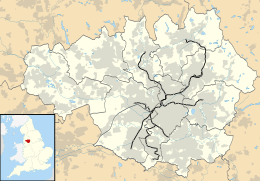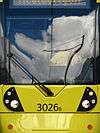Stockport railway station
Stockport railway station in Stockport, Greater Manchester, England is 8 miles south-east of Manchester Piccadilly on the West Coast Main Line to London Euston.
| Stockport | |
|---|---|
.jpg) | |
| Location | |
| Place | Stockport |
| Local authority | Metropolitan Borough of Stockport |
| Grid reference | SJ892898 |
| Operations | |
| Station code | SPT |
| Managed by | Avanti West Coast |
| Number of platforms | 6 (Numbered 0-3, 3a, 4) |
| DfT category | B |
| Live arrivals/departures, station information and onward connections from National Rail Enquiries | |
| Annual rail passenger usage* | |
| 2014/15 | |
| 2015/16 | |
| 2016/17 | |
| 2017/18 | |
| 2018/19 | |
| History | |
| Original company | Manchester and Birmingham Railway |
| Pre-grouping | London and North Western Railway |
| Post-grouping | London, Midland and Scottish Railway |
| 15 February 1843 | Opened as Stockport |
| ? | Renamed Stockport Edgeley |
| 6 May 1968 | Renamed Stockport |
| National Rail – UK railway stations | |
| * Annual estimated passenger usage based on sales of tickets in stated financial year(s) which end or originate at Stockport from Office of Rail and Road statistics. Methodology may vary year on year. | |
History

The Manchester and Birmingham Railway opened in stages from Manchester and reached Stockport in 1840. The 5 1⁄2-mile (9 km) line ran from a temporary station in Manchester to another in Stockport at the north end of the uncompleted Stockport Viaduct. The temporary station which was later renamed Heaton Norris was Stockport's only station for more than two years.[1] After the viaduct was completed, the M&BR built a station at its southern end as an experiment. The decision was prompted by complaints that the first station was a long way from the industrial parts of town and even farther from the residential districts on the south side. The second station opened on 15 February 1843 as Edgeley. By 1844, it was the town's principal station. Heaton Norris, at the north end of the viaduct, closed in 1959.[1]
The station was operated by the London and North Western Railway and became part of the London Midland and Scottish Railway in 1923. In 1948, British Railways ran the system.
Lines into the station were electrified at 25 kV AC, using overhead wires, under the British Railways 1955 Modernisation Plan.
.jpg)
However, not all the local lines were electrified.
Facilities
The station is positioned at high level above the valley of the River Mersey and with lifts that link a pedestrian underpass to central Stockport and Edgeley.
The station is staffed, has a ticket office and ticket machines, customer service points, shops, toilets, waiting rooms, lifts from the station subway and step-free access to the platforms.[2][3]
In 2009, the station was identified as one of the ten worst category B interchange stations for mystery shopper assessment of fabric and environment and received a share of £50m funding for improvements.[4]
Metrolink plans
| Stockport Interchange | |
|---|---|
| Metrolink | |
 Stockport Interchange Location of Stockport Interchange in Greater Manchester | |
| Location | |
| Place | Stockport |
| Local authority | Manchester |
| Coordinates | 53.405°N 2.1628°W |
| Fare zone information | |
| Present status | Proposed station |
A Metrolink extension was proposed in 2004 but dropped on cost grounds. In 2016, it was announced that the plans were revived to extend the line to Stockport.[5] The line will terminate at the railway station.
History
An extension to the line, from East Didsbury to Stockport, was planned in 2004 and GMPTE applied for powers to build it. The project came to a halt when the big bang extension was stopped.[6]
The proposed extension would have reused some of the former railway alignment but some of it was built on or filled in after closure. This made re-opening more difficult and the proposed line would have included new infrastructure and street running sections to take it into Stockport. The line would have terminated at Stockport bus station.[6]
Services
| Preceding station | Following station | |||
|---|---|---|---|---|
| Transport for Wales Welsh Marches Line | Manchester Piccadilly |
|||
| CrossCountry | ||||
Limited Service |
||||
Sheffield | East Midlands Railway | |||
Limited Service |
||||
Limited Service |
||||
Limited Service |
||||
Sheffield | TransPennine Express South TransPennine | |||
Dore & Totley Limited Service |
||||
| Northern Trains | ||||
Manchester Piccadilly |
||||
| Northern Trains Crewe - Manchester Piccadilly | ||||
Manchester Piccadilly |
||||
| Northern Trains Stoke-on-Trent - Manchester Piccadilly | ||||
Manchester Piccadilly |
||||
| Northern Trains | ||||
Davenport | ||||
Manchester Piccadilly |
||||
Navigation Road | Northern Trains Mid-Cheshire Line | |||
Manchester Piccadilly |
||||
Davenport | Northern Trains Monday-Saturday only | |||
| Northern Trains Hope Valley Line Limited service | Manchester Piccadilly |
|||
| Terminus | Northern Trains Saturdays only | |||
London Euston | Avanti West Coast West Coast Main Line | Manchester Piccadilly |
||
| Future Services | ||||
| Preceding station | Following station | |||
towards East Didsbury | Stockport Line Line | Terminus | ||
Current passenger routes
Trains running north-west serve Manchester Piccadilly; some continue on to Manchester Oxford Road and beyond to Liverpool, Preston, Blackpool, Wigan, Southport and Barrow-in-Furness.
South-east from Stockport, express services run to Sheffield and onwards to Cleethorpes, Nottingham and Norwich with local services running to Hazel Grove and Buxton.
The two southbound West Coast Main Line routes run via Cheadle Hulme. One continues via Macclesfield and Stoke-on-Trent to Birmingham and London; the other via Wilmslow and Crewe for through services to London and Birmingham and via Shrewsbury and the Welsh Marches Line to Cardiff, Carmarthen, Pembroke Dock and Milford Haven. Trains to Birmingham continue to destinations in the south of England such as Bournemouth via Reading and Bristol Temple Meads.
The Mid-Cheshire Line runs westbound through Altrincham, Knutsford, Northwich to Chester.
The Stockport to Stalybridge Line, via Guide Bridge, no longer has a regular passenger service. It was reduced from an hourly shuttle service to a once a week, one direction only skeleton service in the early 1990s. It now run two services, one in either direction on Saturday mornings.
The main concourse opened in September 2004 in a development that included a new platform (platform 0) that only became fully operational at the beginning of March 2008. A pedestrian subway leads to the island platforms, which have a buffet and newsagent.
The weekday service pattern is (tph = trains per hour):
- Transport for Wales
- 1 tph to Manchester Piccadilly
- 1 tph to Carmarthen/Milford Haven via Shrewsbury and Cardiff Central[7]
- CrossCountry
- 2 tph to Manchester Piccadilly
- 1 tph to Bournemouth via Stoke-on-Trent and Birmingham New Street
- 1 tph to Bristol Temple Meads via Stoke-on-Trent and Birmingham New Street,[8] of which some continue to Paignton or Plymouth.
- East Midlands Railway
- 1 tph to Liverpool Lime Street
- 1 tph to Norwich via Sheffield and Nottingham[9]
- TransPennine Express
- 1 tph to Cleethorpes
- 1 tph to Manchester Airport via Manchester Piccadilly[10]
- Northern Trains
- 6 tph to Manchester Piccadilly (with 1 tph continuing to Bolton and Wigan North Western)[11]
- 2 tph to Alderley Edge (with 1 tph continuing to Crewe)
- 3 tph to Hazel Grove (with 2 tph continuing to Buxton)
- 1 tph to Chester[12]
- 1 tph to Stoke-on-Trent via Macclesfield
- 1 train per week to Stalybridge[13]
- Avanti West Coast
- 3 tph to Manchester Piccadilly
- 2 tph to London Euston via Stoke-on-Trent
- 1 tph to London Euston via Crewe[14]
Platform use
Platform 0 - Typically services to Hazel Grove, Buxton, Sheffield, Norwich, Nottingham and Cleethorpes (opened in 2003).
Platform 1 - southbound services to Macclesfield, Crewe, Stoke-on-Trent and Alderley Edge. It is also signalled for use by trains in the Manchester direction.
Platform 2 - southbound platform for services to Stoke-on-Trent, Chester, Crewe, Alderley Edge, services to South Wales, London, Bristol, Bournemouth, Paignton and Plymouth.
Platform 3 - mainly used by Fast services to Manchester Piccadilly along with services to Manchester Airport, Liverpool Lime Street, Blackpool North, Preston, Salford Crescent, Bolton, Wigan, Southport and Barrow-in-Furness.
Platform 3a - used by the weekly Parliamentary train from / to Stalybridge.
Platform 4 - mainly used by stopping services to Manchester Piccadilly along with services to Manchester Airport, Liverpool Lime Street, Blackpool North, Preston, Salford Crescent, Bolton, Wigan, Southport and Barrow-in-Furness.
Non-stopping trains
It has been claimed that Stockport viaduct was built on condition that all passenger trains were required to stop at Stockport station.[15][16][17]
References
- Holt, Geoffrey O (1978). A Regional History of the Railways of Great Britain. Volume 10: North West. David & Charles. pp. 117–119. ISBN 0715375210.
- National Rail Enquiries - Station facilities for Stockport Accessed 2014-06-03
- Stockport Station Plan Accessed 2014-06-03
- "£50m revamp for 'worst stations'". BBC News. 17 November 2009. Retrieved 17 November 2009.
- Fitzgerald, Todd (1 February 2016). "Revealed: Stockport train station's multi-million pound transformation plans". Manchester Evening News. Retrieved 7 August 2016.
- "Metrolink, East Didsbury to Stockport". LRTA. Retrieved 27 January 2016.
- Table 131 National Rail timetable, May 2016
- Table 51 National Rail timetable, May 2016
- Table 49 National Rail timetable, May 2018
- Table 29 National Rail timetable, May 2016
- Table 82, 84 & 86 National Rail timetable, May 2018
- Table 88 National Rail timetable, May 2018
- Table 78A National Rail timetable, May 2018
- Table 65 National Rail timetable, May 2016
- Andrew Macfarlane, ed. (1989). "Manchester–Buxton". Peaks and Plains by Rail. Railway Development Society. Norwich: Jarrold Colour Publications. p. 19. ISBN 0-7117-0429-5.
- "Concern over proposed train cuts". BBC News. 5 December 2007. Retrieved 9 March 2008.
- "Register your viaduct vote online for trains to stop". Stockport Express News Website. MEN. 26 March 2008. Archived from the original on 25 March 2008. Retrieved 26 March 2008.
Further reading
- Mitchell, Vic; Smith, Keith (2014). Crewe to Manchester. Middleton Press. figs. 78-88. ISBN 9781908174574. OCLC 892047119.
External links
| Wikimedia Commons has media related to Stockport railway station. |
- Train times and station information for Stockport railway station from National Rail

